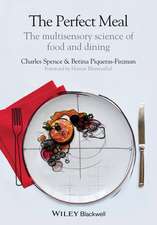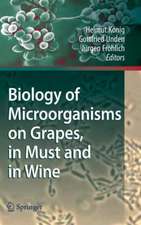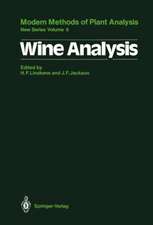The Impact of Food Bioactives on Health: in vitro and ex vivo models
Editat de Kitty Verhoeckx, Paul Cotter, Iván López-Expósito, Charlotte Kleiveland, Tor Lea, Alan Mackie, Teresa Requena, Dominika Swiatecka, Harry Wichersen Limba Engleză Hardback – 19 mai 2015
Preț: 389.17 lei
Nou
Puncte Express: 584
Preț estimativ în valută:
74.47€ • 77.31$ • 62.10£
74.47€ • 77.31$ • 62.10£
Carte tipărită la comandă
Livrare economică 20-26 martie
Preluare comenzi: 021 569.72.76
Specificații
ISBN-13: 9783319157917
ISBN-10: 3319157914
Pagini: 348
Ilustrații: XVII, 338 p. 57 illus., 35 illus. in color.
Dimensiuni: 155 x 235 x 20 mm
Greutate: 0.68 kg
Ediția:2015
Editura: Springer International Publishing
Colecția Springer
Locul publicării:Cham, Switzerland
ISBN-10: 3319157914
Pagini: 348
Ilustrații: XVII, 338 p. 57 illus., 35 illus. in color.
Dimensiuni: 155 x 235 x 20 mm
Greutate: 0.68 kg
Ediția:2015
Editura: Springer International Publishing
Colecția Springer
Locul publicării:Cham, Switzerland
Public țintă
ResearchCuprins
Introduction.- Gastrointestinal digestion models, general introduction.- Static digestion models general introduction.- InfoGest consensus method.- Approaches to static digestion models.- Dynamic digestion models general introduction.- The TNO gastro-Intestinal Model (TIM).- Dynamic Gastric Model (DGM).- Human Gastric Simulator (Riddet model).- The DIDGI® System.- General introduction to cells, cell lines and cell culture.- Epithelial cell models; General introduction.- Caco-2 cell line.- HT29 cell line.- The IPEC-J2 cell line.- Co-cultivation of Caco-2 and HT-29MT.- Innate and adaptive immune cells; General introduction.- THP-1 and U937 cells.- Peripheral blood mononuclear cells.- PBMC-derived T cells.- Dendritic Cells.- Co-culture Caco-2/ immune cells.- Enteroendocrine Cell Models: General introduction.- STC-1 cells.- NCI-H716 cells.- Murine GLUTag cells.- In vitro intestinal tissue models: General introduction.- Intestinal crypt organoids as experimental models.- Porcine ex vivointestinal segment model.- Ussing chamber.- In vitro fermentation models: General Introduction.- One compartment fermentation model.- The TNO in vitro model of the colon - TIM-2.- The Simulator of the Human Intestinal Microbial Ecosystem – SHIME®.- The computer-controlled multicompartmental dynamic model of the gastrointestinal system SIMGI.
Textul de pe ultima copertă
This book describes in vitro and ex vivo models that can be employed to investigate effects of digested food products on the GIT, or specific components thereof. Many such models exist and include, for example, those used to study digestion and fermentation in the small and large intestine, to investigate absorption (e.g. Ussing chamber, epithelial cell systems), and to research the immune and enteroendocrine responses (e.g. macrophages, dendritic cells, co-cultures). In each case, these respective assays and models are discussed, and tips and tricks concerning their proper use are given. The Impact of Food Bioactives on Health: In Vitro and Ex Vivo Models is an asset to researchers wishing to study the health benefits of their foods and food bioactives of interest. The book highlights which in vitro/ex vivo assays are of greatest relevance to their goals, what sort of outputs/data can be generated, and highlights the strengths and weaknesses of the various assays. It is also an important resource for under-graduate students in the ‘food and health’ arena.
Caracteristici
Important contribution to "food and health" research Highlights the strengths and weaknesses of various assays Covers what outputs/data can be generated Includes supplementary material: sn.pub/extras









